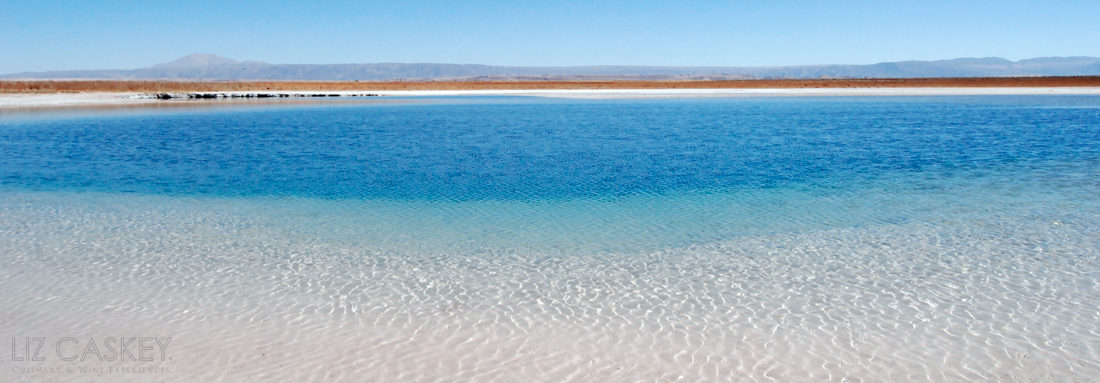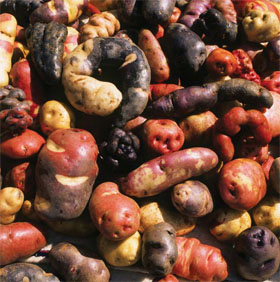Fall in Chile is synonymous with the potato harvest in the south where dozens upon dozens of colorful native potatoes are unearthed from dark, fertile soil. Purple, red, pink, yellow, spotted, striped, tinged, oblong, round, knobby, and thin, they are infinite in their expressions. They range in flavor from earthy to almost beet-like and strawberry with textures from pillowy and creamy to more firm like a yam.
Like many people, I took the humble spud for granted before I arrived in Chile. I thought the varieties were basically Russet. Beyond mashed potatoes, French fries, and greasy thick-cut Lancaster county potato chips, there wasn’t a whole lot of diversity to these tasty tubers. Damn, was I wrong—and I am repentenant at my lack of knowledge and respect for the holy papa (which funny enough, also means “pope” in Spanish).
Potato harvest aside, Chileans year-round are serious paperos, a term in Spanish that loosely translates to “potato lovers”. Potatoes are one of the basic starches in the Chilean diet, particularly during the hearty winter months after the corn season has finished. Potatoes can be stored in a dry, cool place for easy cooking. Along with dried legumes and beans from the summer months, Chileans crave their calories and warm nostalgia in many seasonal potato dishes.
Just to contextualize the potato in the world, it is the world’s fourth largest food staple after rice, wheat, and corn. There has been a long debate between Chile and Peru as to the origin of the potato, born from a single ancestor known as Solanum Brevicaule. Some studies of wild varieties have suggested that the potato was born in the southern Andean region although scientisits believe today that 99% of all potatoes are genetic descendants of a subspecies indigenous to Chile on the island of Chiloé where the tubers were cultivated 10,000 years ago.
While I don’t want to spark a Chile v. Peru potato debate, there are hundreds of varieties in both countries. My focus here is on the potato fest happening in Chile right now. In the south in Chiloé, there are projects headed by women who are heirloom potato keepers that have faithfully kept the seeds and varieties going from generations before. The potatoes today grow in their family gardens and are taken to local markets. The trend is catching on up in Santiago where small farmers send their crop from the south for us to savor in the capital. Below are some of the classic Chilean potato dishes that are eaten in the south and throughout the country. In our home here in Santiago, our maid Mimí, who hails from Temuco, cannot seem to go a day or so without preparing a potato dish. My Chilean husband is in heaven. After all, he’s a papero.
Milcao: a traditional food from the Chiloé archipelago, there are numerous versions that are fried or steamed. The basic recipe however is for raw native potatoes to be peeled, grated, and squeezed in a dry towel to extract all the water. Another part are cooked and pureed and they are combined and shaped into a circular fritter. These are normally fried and and at tea time, I observed that the locals slathered them with honey. These are steamed when prepared with the traditional curanto, a surf and turf meal prepared in the ground and covered with nalca leaves.
Chapalele: Made with mashed potatoes and flour, this is another specialty from Chiloé. Rolled together into little croquettes, they are particularly tasty since pork lard and thick chunks of chicharrón, bacon, are added. Although these can be fried, most commonly they come steamed as part of a curanto, or are made at home. Once again, honey and sugar are the usual suspects when these are consumed in lieu of bread at onces, tea time.
Spicy Mashed Potatoes: Pure potato lovin’. Best when made with yellow potatoes from the Osorno (lake) region, chili sauce is pan-fried in lightly browned butter and folded into hot, boiled potatoes passed through the ricer. They use only the boiling water to create the fluffy texture (no dairy necessary). Add a sprinkling of Chilean sea salt and you have pillowy, piquant heaven.
Pastel de Papas/Potato Pie: Given that corn’s season is short (January-April), the potato replaces maize in this winter variation of the classic national dish, Pastel de Choclo. The cumin-tinged filling with black olives and raisins remains the same but the chicken is omitted. It totally reminds me of a Latin Shepherd’s pie–minus the Worchestershire sauce.
Papas Five Ways: My father-in-law brings a 20 kilo sack of potato every winter for us which stretches my imagination as to what to do with these spuds. I usually first exhaust the obvious (gnocchi, gnocchi, gnocchi). Mimí prepares them for us boiled (to accompany pork or meat) with spicy pebre, pan-fried, roasted, mashed using on the salted water (no milk or butter necessary down here), or in the ubiquitous potato salad. Potato salad in Chile usually means papas al mayo, or potato bathed, no drowned, in copious amounts of homemade mayo with a dash of herbs.













